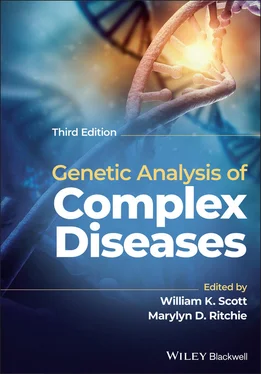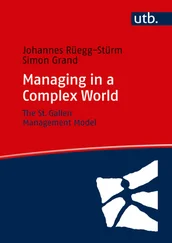Genetic Analysis of Complex Disease
Здесь есть возможность читать онлайн «Genetic Analysis of Complex Disease» — ознакомительный отрывок электронной книги совершенно бесплатно, а после прочтения отрывка купить полную версию. В некоторых случаях можно слушать аудио, скачать через торрент в формате fb2 и присутствует краткое содержание. Жанр: unrecognised, на английском языке. Описание произведения, (предисловие) а так же отзывы посетителей доступны на портале библиотеки ЛибКат.
- Название:Genetic Analysis of Complex Disease
- Автор:
- Жанр:
- Год:неизвестен
- ISBN:нет данных
- Рейтинг книги:4 / 5. Голосов: 1
-
Избранное:Добавить в избранное
- Отзывы:
-
Ваша оценка:
- 80
- 1
- 2
- 3
- 4
- 5
Genetic Analysis of Complex Disease: краткое содержание, описание и аннотация
Предлагаем к чтению аннотацию, описание, краткое содержание или предисловие (зависит от того, что написал сам автор книги «Genetic Analysis of Complex Disease»). Если вы не нашли необходимую информацию о книге — напишите в комментариях, мы постараемся отыскать её.
An up-to-date and complete treatment of the strategies, designs and analysis methods for studying complex genetic disease in human beings Genetic Analysis of Complex Diseases
Genetic Analysis of Complex Diseases
Genetic Analysis of Complex Diseases
Genetic Analysis of Complex Disease — читать онлайн ознакомительный отрывок
Ниже представлен текст книги, разбитый по страницам. Система сохранения места последней прочитанной страницы, позволяет с удобством читать онлайн бесплатно книгу «Genetic Analysis of Complex Disease», без необходимости каждый раз заново искать на чём Вы остановились. Поставьте закладку, и сможете в любой момент перейти на страницу, на которой закончили чтение.
Интервал:
Закладка:
Library of Congress Cataloging‐in‐Publication Data
Names: Scott, William K., 1970– editor. | Ritchie, Marylyn DeRiggi, 1977– editor.
Title: Genetic analysis of complex diseases / edited by William K. Scott and Marylyn D. Ritchie.
Description: Third edition. | Hoboken, NJ : Wiley‐Blackwell, 2022. | Preceded by Genetic analysis of complex diseases / [edited by] Jonathan L. Haines, Margaret Pericak‐Vance. 2nd ed. c2006. | Includes bibliographical references and index.
Identifiers: LCCN 2021009896 (print) | LCCN 2021009897 (ebook) | ISBN 9781118123911 (paperback) | ISBN 9781119104087 (adobe pdf) | ISBN 9781119104070 (epub)
Subjects: MESH: Genetic Diseases, Inborn–genetics | Disease–genetics | Chromosome Mapping–methods | Genetic Predisposition to Disease | Research Design | Genetic Research
Classification: LCC RB155 (print) | LCC RB155 (ebook) | NLM QZ 50 | DDC 616/.042–dc23
LC record available at https://lccn.loc.gov/2021009896LC ebook record available at https://lccn.loc.gov/2021009897
Cover Design: Wiley
Cover Image: © ESB Professional/Shutterstock
List of Contributors
Susan H. Blanton Dr. John T. Macdonald Foundation Department of Human Genetics University of Miami Miller School of Medicine Miami, FL, USA
Adam Buchanan Genomic Medicine Institute Geisinger Danville, PA, USA
William S. Bush Department of Population and Quantitative Health Sciences Case Western Reserve University Cleveland, OH, USA
Ren-Hua Chung Institute of Population Health Sciences Division of Biostatistics and Bioinformatics National Health Research Institutes (Taiwan) Hsinchu, Taiwan
Dana C. Crawford Department of Population and Quantitative Health Sciences Case Western Reserve University Cleveland, OH, USA
Abigail Deppen InformedDNA St Petersburg, FL, USA
Logan Dumitrescu Department of Neurology Vanderbilt University Nashville, TN, USA
Kayla Fourzali University of Miami Miller School of Medicine Miami, FL, USA
Susan Estabrooks Hahn Genomic Services Quest Diagnostics North Andover, MA, USA
Jonathan L. Haines Department of Population and Quantitative Health Sciences Case Western Reserve University Cleveland, OH, USA
Dale J. Hedges Center for Applied Bioinformatics St. Jude Children’s Research Hospital Memphis, TN, USA
Elizabeth Heise Clinical Genetics Program GeneDX, Inc Gaithersburg, MD, USA
Allison Ashley Koch Duke Molecular Physiology Institute Duke University Medical Center Durham, NC, USA
Eden R. Martin Dr. John T. Macdonald Foundation Department of Human Genetics University of Miami Miller School of Medicine Miami, FL, USA
Jacob L. McCauley Dr. John T. Macdonald Foundation Department of Human Genetics University of Miami Miller School of Medicine Miami, FL, USA
Sarah A. Pendergrass Human Genetics Genentech San Francisco, CA, USA
Margaret A. Pericak-Vance Dr. John T. Macdonald Foundation Department of Human Genetics University of Miami Miller School of Medicine Miami, FL, USA
Evadnie Rampersaud Center for Applied Bioinformatics St. Jude Children’s Research Hospital Memphis, TN, USA
Marylyn D. Ritchie Department of Genetics Perelman School of Medicine at the University of Pennsylvania Philadelphia, PA, USA
William K. Scott Dr. John T. Macdonald Foundation Department of Human Genetics University of Miami Miller School of Medicine Miami, FL, USA
Stephen D. Turner Signature Science LLC Charlottesville, VA, USA
Shefali Setia Verma Department of Pathology and Laboratory Medicine Perelman School of Medicine at the University of Pennsylvania Philadelphia, PA, USA
Yogasudha Veturi Department of Genetics Perelman School of Medicine at the University of Pennsylvania Philadelphia, PA, USA
Chantelle Wolpert Physician Assistant Program Thomas Jefferson University Philadelphia, PA, USA
Foreword
This book grew from our four‐day NIH‐sponsored course, which, for 20 years, was focused on providing an overview and guide to the design and execution of human genetic mapping studies for these common (and genetically complex) diseases, melding the genomic technology with the statistical rigor needed to apply and interpret the results. When we developed the concept for the first edition of this book in 1996, the Human Genome Project was just reaching full speed, combining continual breakthroughs in DNA gene mapping and sequencing technology with emerging applications to human disease to shed the first light on the organization of the human genome and the variations that cause disease. The first applications of the Human Genome Project data were to find the location, and ultimately the causative mutations, for rare Mendelian inherited diseases. It was dogma then that the genetic architecture of common diseases was beyond our reach, based on the naïve belief that Mendelian disease represented how genetic variation impacted disease. However, we soon demonstrated, with the discovery that multiple apolipoprotein E ( APOE) alleles had differing and strong effects on the risk of Alzheimer disease, that these technologies and approaches could be adapted to illuminate the genetic underpinnings of common diseases.
The rapid advances in both DNA technology and statistical methodology demanded that a significant update to the book was needed, with the second edition of the book in 2006. By this point the blood and protein markers of the 1970s had been surpassed by the restriction fragment length polymorphisms (RFLPs) of the 1980s, the microsatellite repeats of the 1990s, and the single nucleotide polymorphisms (SNPs, of which RFLPs are a subset) for the past 20 years. Naturally, the analyses of these data also advanced from early mainframe applications of genetic linkage analysis in small numbers of families, to PC‐powered analyses of thousands of cases and controls for association.
In the past 15 years since that second edition, increasingly dense SNP arrays and whole exome or whole genome sequencing have created new horizons for dissecting complex diseases. In addition, the explosion of other “omics” data, particularly gene expression data, provide biological context for the discovered DNA variations, adding biological interpretation as a critical element of genetic studies.
With all these advances, it became apparent that a new edition of this book was warranted, and new and fresh perspectives were needed. Thus, we turned over the editing of this new edition to two of our brilliant younger colleagues, who have been active in both developing and applying methods at the forefront of genetics and genomics. While the inclusion of genome‐wide association studies, integration of genomic data, and data mining are new, the breadth of the book in describing the overall process of designing and executing successful projects remains.
Finally, we fondly acknowledge the continuing impact of our mentor, Dr. P. Michael Conneally, who inspired both of us to inquire, question, investigate, and solve, the often difficult, constantly emerging human genetic puzzles. He encouraged us to help educate researchers, physician‐scientists, and physicians in the complex nature of genetic studies. He wrote the forward for the first two editions, and although he passed away in 2017, his legacy remains in our work and the work of our trainees and collaborators.
We are immensely grateful to Bill and Marylyn for taking on this important task and developing this excellent third edition of the book.
Jonathan L. Haines, PhD
Margaret A. Pericak‐Vance, PhD
1 Designing a Study for Identifying Genes in Complex Traits
Интервал:
Закладка:
Похожие книги на «Genetic Analysis of Complex Disease»
Представляем Вашему вниманию похожие книги на «Genetic Analysis of Complex Disease» списком для выбора. Мы отобрали схожую по названию и смыслу литературу в надежде предоставить читателям больше вариантов отыскать новые, интересные, ещё непрочитанные произведения.
Обсуждение, отзывы о книге «Genetic Analysis of Complex Disease» и просто собственные мнения читателей. Оставьте ваши комментарии, напишите, что Вы думаете о произведении, его смысле или главных героях. Укажите что конкретно понравилось, а что нет, и почему Вы так считаете.











